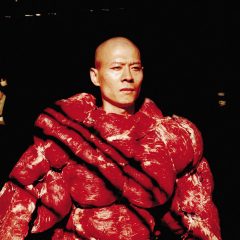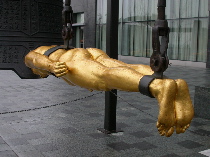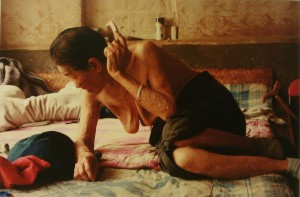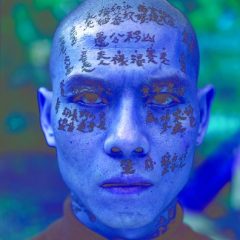
I suppose it comes as no surprise that modern Chinese artists are using old Chinese art forms–not to mention quite recent ones, but those were usually parodies. So the scroll was a constant visual presence in the International Center of Photography’s piece of the “Between Past and Future: New Photography and Video from China” show. (For some comments on the Asia Society piece of the exhibit, see my post from last week.)
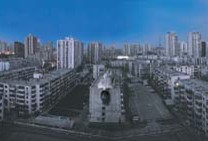 But these are not your father’s scrolls. Chen Lingyang’s scroll-length nighttime cityscape, “25:00, No.2,” stuns with an Olympian-sized naked woman lying on a rooftop, her hair hanging down. The naked woman by no means fulfills a Western concept of titillation; after all, we don’t see much of her. But the pale undulation of skin and fall of hair are such a contrast to the hard materials of the rectilinear modern buildings that her sensuality, humanity and vulnerability are unmistakable. The piece pulls off a hip, Western modernity while it nods to the scroll (top and detail, left).
But these are not your father’s scrolls. Chen Lingyang’s scroll-length nighttime cityscape, “25:00, No.2,” stuns with an Olympian-sized naked woman lying on a rooftop, her hair hanging down. The naked woman by no means fulfills a Western concept of titillation; after all, we don’t see much of her. But the pale undulation of skin and fall of hair are such a contrast to the hard materials of the rectilinear modern buildings that her sensuality, humanity and vulnerability are unmistakable. The piece pulls off a hip, Western modernity while it nods to the scroll (top and detail, left).
It also bespeaks the presence of these artists living in downtown cityscapes, a repeat motif in the two shows.
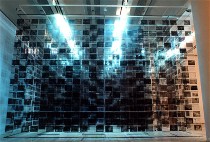
Hu Jieming hung flat, transparent, shower curtain-like pieces of plastic from wooden dowels, creating walls for a maze. The images are television screens and computer images from a year, in this case “1995-1996,” which is the name of the piece. Inside the maze, the black-and-white images–a mix of Western and Eastern programing–become irritations that prevent a clear view of the world around you. I presume that’s his point. I found an image on the Web that looked pretty much the same, a Hu piece called “The Fiction Between 1999 and 2000” (right).
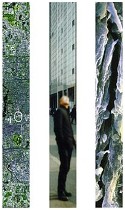 Trying to find his place in the brave new world of modern day China, Li Tianyuan took a triptych of scroll-like pictures, one showing a satellite view of him circled, one a street view of him, and one a microscopic image of his fingernail, which had the qualities of a layered landscape(left, “Space Station 12 Dec. 2000”).
Trying to find his place in the brave new world of modern day China, Li Tianyuan took a triptych of scroll-like pictures, one showing a satellite view of him circled, one a street view of him, and one a microscopic image of his fingernail, which had the qualities of a layered landscape(left, “Space Station 12 Dec. 2000”).
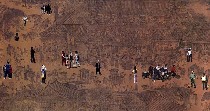
And on Hong Hao’s 35-foot facsimile scroll, “Spring Festival on the River,” based on a 12th century representation of Beijing, he cut and pasted tiny pictures of some of the current inhabitants. (Right, another Web image that looked like a detail of the same thing, but I was unable to tell if it really was the same from the labeling; anyway, you get the picture).
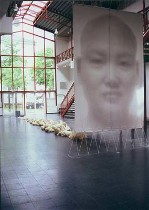 But the scroll that sets the tone for the show is at the entrance, a huge silk-screen print of the artist’s face on an enormous canvas hung from a dowel, knots punctuating the face. Behind the scroll, the strings that begin at the knots are pulled back to form an enormous braid that serpentines across the floor. Part of what’s so striking about Lin Tianmiao’s installation is the sheer bravado with which she declares her individuality, the ultimate People’s Republic of China no-no. She dares a bombastic Western-style art scale and Western-style canvas material, but she preserves the scroll format and the ancient Chinese hairstyle.
But the scroll that sets the tone for the show is at the entrance, a huge silk-screen print of the artist’s face on an enormous canvas hung from a dowel, knots punctuating the face. Behind the scroll, the strings that begin at the knots are pulled back to form an enormous braid that serpentines across the floor. Part of what’s so striking about Lin Tianmiao’s installation is the sheer bravado with which she declares her individuality, the ultimate People’s Republic of China no-no. She dares a bombastic Western-style art scale and Western-style canvas material, but she preserves the scroll format and the ancient Chinese hairstyle.
Grids
I also was taken aback by the prevalence of grids. But these were not the grids of Minimalism. Rather, they were sort of scroll-like, using the grid boxes like movie frames to express time passing.
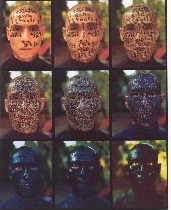 Zhang Huan’s “Family Tree” (right) shows his head being covered character by character with Chinese words until, ultimately, his head is completely covered with black ink. The title suggests his family ties and ancestry are overwhelming his individuality. I don’t know what the characters say, whether they are names or other words, but before I read the title, I at first read the piece as China, its language, its government propaganda obliterating individuality.
Zhang Huan’s “Family Tree” (right) shows his head being covered character by character with Chinese words until, ultimately, his head is completely covered with black ink. The title suggests his family ties and ancestry are overwhelming his individuality. I don’t know what the characters say, whether they are names or other words, but before I read the title, I at first read the piece as China, its language, its government propaganda obliterating individuality.
 The contact sheet by Zheng Guogu of his friends partying, “Life and Dreams of the Youth of Yanjiang” was both a very long scroll in grid form and a quilt. Again, I was in the never-never-land of the Web, and I found this image (left), which has a similar name, “Youth Life and Dream.” I suspect it’s the same image with a slightly different translation for the name.
The contact sheet by Zheng Guogu of his friends partying, “Life and Dreams of the Youth of Yanjiang” was both a very long scroll in grid form and a quilt. Again, I was in the never-never-land of the Web, and I found this image (left), which has a similar name, “Youth Life and Dream.” I suspect it’s the same image with a slightly different translation for the name.
Who are you?
 I have to mention one other piece, which has nothing to do with grids or scrolls. It’s by Hong Hao, the same artist who added little cutout photos of modern people to a facsimile of an ancient scroll. His “I Know Mr. Gnoh,” a large chromagenic print (there were an awful lot of large Chromagenic prints in both shows, especially at the Asia Society) of himself dressed up as a skinny Chinese version of a fat-cat Westerner, his slightly worried eyes Photoshopped blue, his hair, blond. This was straightforward in content and full of laugh-out-loud details, like his too widely knotted tie. As funny as this piece was, it was dead serious–a search for himself behind the invading Western imagery.
I have to mention one other piece, which has nothing to do with grids or scrolls. It’s by Hong Hao, the same artist who added little cutout photos of modern people to a facsimile of an ancient scroll. His “I Know Mr. Gnoh,” a large chromagenic print (there were an awful lot of large Chromagenic prints in both shows, especially at the Asia Society) of himself dressed up as a skinny Chinese version of a fat-cat Westerner, his slightly worried eyes Photoshopped blue, his hair, blond. This was straightforward in content and full of laugh-out-loud details, like his too widely knotted tie. As funny as this piece was, it was dead serious–a search for himself behind the invading Western imagery.


